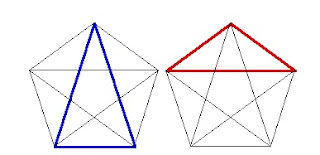Technical language is derived from common language to allow
more accurate and precise statements, and more penetrating and perceptive
questions. Commonly, when we say “real” we mean “true”, independent of the observer,
valid, or verifiable, actual; not imaginary or mythical. Pegasus was not a real
animal. Polyphemus the Cyclops was
not real, though Odysseus may well have been. In mathematics, “real” numbers
are the set that includes all integers, rational, and irrational numbers.
“Imaginary” numbers are those whose square (or other “even” power) is a
negative number; in other words, the square roots of negative numbers are
imaginary. But imaginary numbers are real in the common sense.
 |
| Euler's Equation. As sin^2(x) + cos^2(x) = 1 this can be applied to the analysis of alternating current electricity. |
 |
| The Golden Ratio seen in the Parthenon has many applications. Geometrically pleasing, its algebraic expression (1 + sqrt(5))/2 is irrational |
Diophantus of Alexandria (3rd century CE) denied the reality of negative numbers. The Nine Chapters on Mathematical Art (Jiu zhang suan-shu) of about the same time accepted their reality. Although early conceptions of zero as a placeholder are known from Babylonian and Egyptian texts, zero was not accepted as a number in the modern sense until about 500 CE. What is nothing? And in the technical language of metaphysics, nothing is not a different kind of something. “Nothing exists beyond the universe” does not mean that “beyond the universe” is “something else.” The confusion over zero comes from the difference between “nothing” and “none.” The number 207 has no tens; it does not have metaphysical “nothing” in the tens place.
But we are not confused by that in daily life. When Mom asked “What’s going on?” and you replied “Nothing!” she was not thrown into a metaphysical conundrum.
So, too, with imaginary numbers. They have an unfortunate etymology, but we use them every day. If the operators in control rooms of electrical power plants could not manipulate reactive power – expressed in imaginary numbers—with real controls, we would suffer blackouts.
My motivation here is a post on the Galt’s Gulch Online discussion board. On April 5, 2016, about 7:00 AM local time, frequent contributor ewv wrote: “Mathematics by itself doesn't describe reality. It is the means by which you relate in terms of concepts what can be measured. Mathematics is a science of method, not about things like physics does.” (Reply here in "What is Science?" here.)
Her keyboading error aside (“physics does” for “physics is”), she is usually a very adept student of Objectivism. As a quip, I once accused her of being Dr. Leonard Peikoff. Her comment about mathematics was a direct derivation of statements by Ayn Rand in Introduction to the Objectivist Epistemology, as well as elucidations by David Harriman in The Logical Leap. However, mathematics does describe reality, as does any language.
We can give expression to falsehoods using common language, as when we attempted to deflect Mom’s inquiry about our noisy play. Pegasus and Nike of Samothrace are other examples. They are mathematically impossible. Whatever the wings represent symbolically, they cannot function from the meager muscles on the back of the horse or the girl. Arguments about politics and religion, and Monday morning quarterbacking supply a surfeit of such falsehoods. That silliness is impossible in mathematics.
 |
| Patent for application of the Moebius strip to a power conveyor. |
Mathematics does have unsolved challenges. Science always has frontiers. However, anything that is proved to be mathematically true must be realizable, even if we have not found one or built one yet.
ALSO ON NECESSARY FACTS
No comments:
Post a Comment
Note: Only a member of this blog may post a comment.